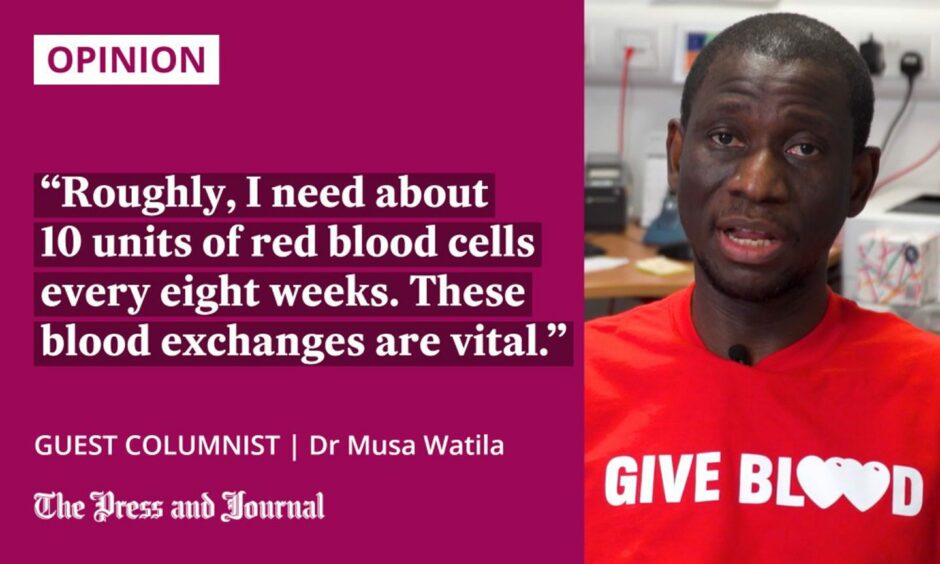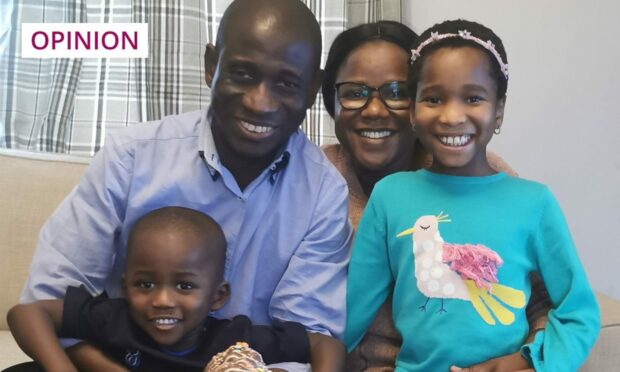My name is Musa Watila. I live in Aberdeen and work as a medical doctor.
I am married to a wonderful and supportive lady, Ruth. We have two kids who are eight and three years old.
I have a condition called sickle cell disease (SCD). It is an inherited disorder of the red blood cells.
The red blood cells are involved in carrying oxygen around the body. They are meant to be round, smooth and bendable – like a jelly doughnut. In SCD, the red blood cells become sickle-shaped – like a new moon – and less bendable, as they move through the tinier blood vessels.

They clump together, blocking these vessels, causing inflammation and swelling, and leading to severe, painful crises in the bones and internal organs. Over time, these crises build up, causing organ damage.
Sickle cell crises are very painful. Severe bone pain or abdominal crises can be indescribably excruciating. I get at least one crisis in a month or every couple of months, and sometimes this used to lead to hospital admission, making me miss school or work for days or even a couple of weeks.
It impacted negatively on my quality of life, through frequent painful crises, and I was not able to exercise as much as others. In my final year of medical school, I had a severe crisis that caused damage to my hip joints, resulting in two hip replacements.
Your blood donations keep me pain-free
Currently, I get red cell exchange transfusions at Aberdeen Royal Infirmary. This procedure involves being attached to an apheresis machine. This machine removes my sickle-shaped blood cells and replaces them with healthier red blood cells from donors. It takes three to four hours for this treatment, every eight weeks.
My family depends on your blood donations: they are happier if I am healthier
Since starting regular red cell exchange transfusions, I have not had any crises, and my quality of life has improved. I have better exercise tolerance.
Roughly, I need about 10 units of red blood cells every eight weeks. These blood exchanges are vital. If I don’t get them, my body will keep producing sickle cells and that means more crises, more complications, poorer exercise tolerance, poorer quality of life and a higher risk of death.
Dr Musa Watila, specialty doctor in Neurology at #Aberdeen Royal Infirmary. He was less than a year old when his parents discovered he had #SickleCellDisease. https://t.co/skmyoQBYAF #GiveBlood this festive season.
🌲https://t.co/Im2ssUNx9r ☃️0345 90 90 999 @NHSGrampian pic.twitter.com/CsiKIiXnrR— SNBTS-Scottish National Blood Transfusion Service (@givebloodscot) December 15, 2021
As a doctor, I won’t be able to serve the NHS effectively. That means more time away from work on sick leave.
I would like to thank all those who have donated blood. Your blood donations keep me pain-free, stronger and more efficient as a doctor. My family depends on your donations: they are happier if I am healthier.
For those who are considering giving blood, please do. Donating is safe and a literal lifesaver for those who need regular transfusions.
Dr Musa Watila specialises in neurology at Aberdeen Royal Infirmary


Conversation